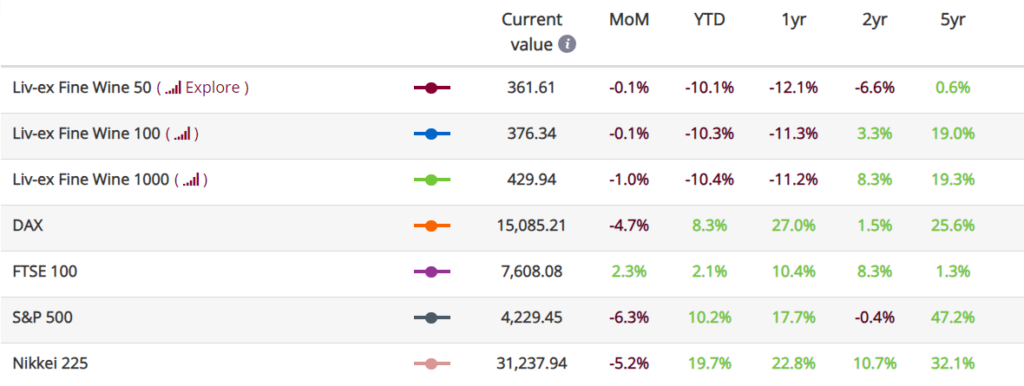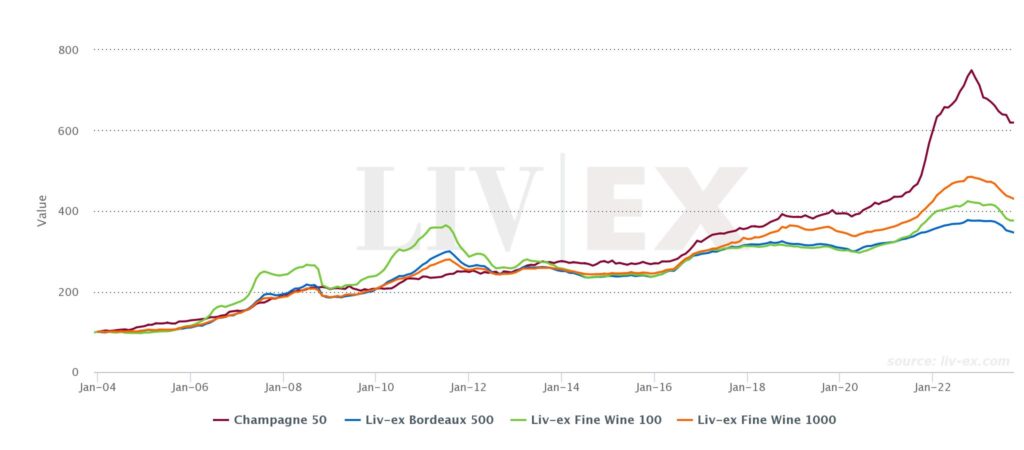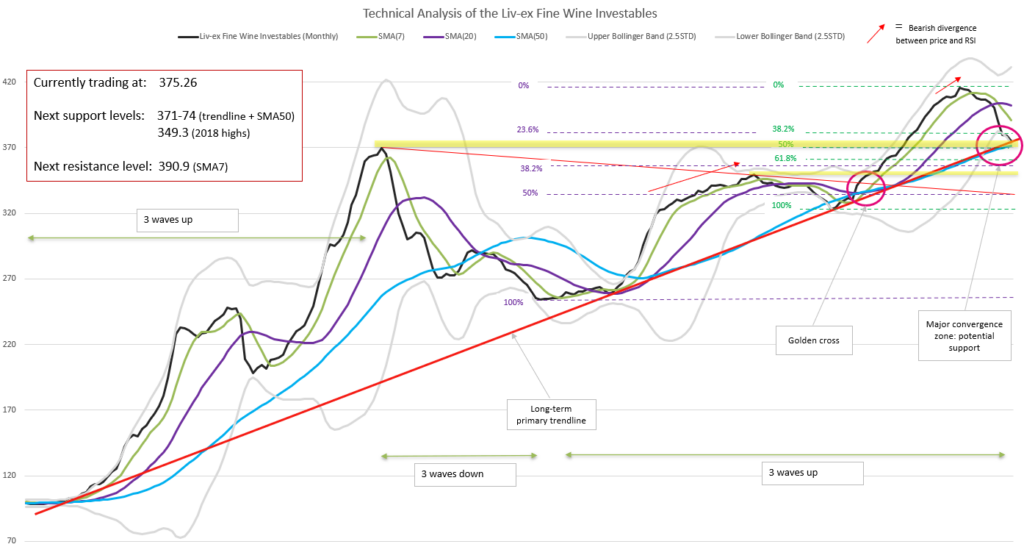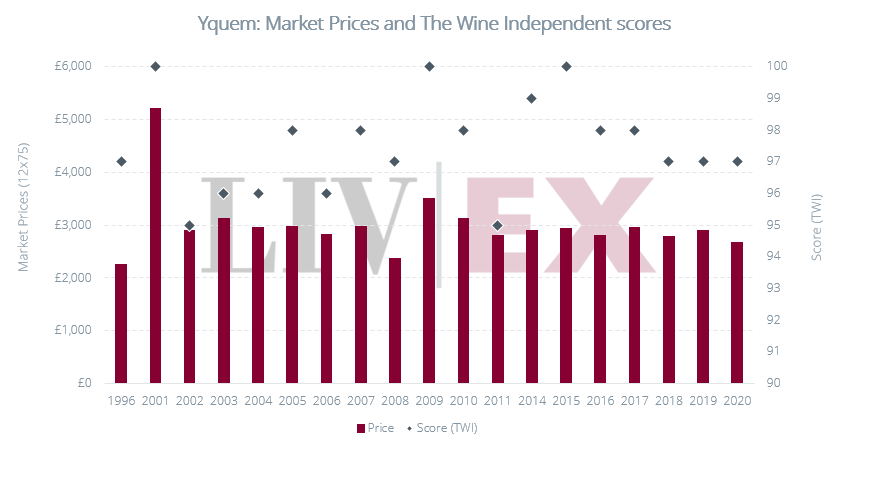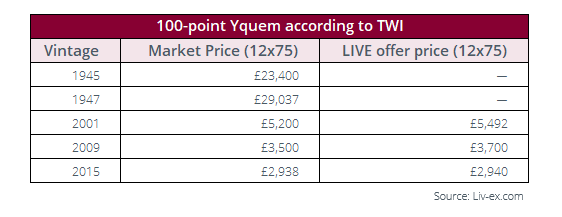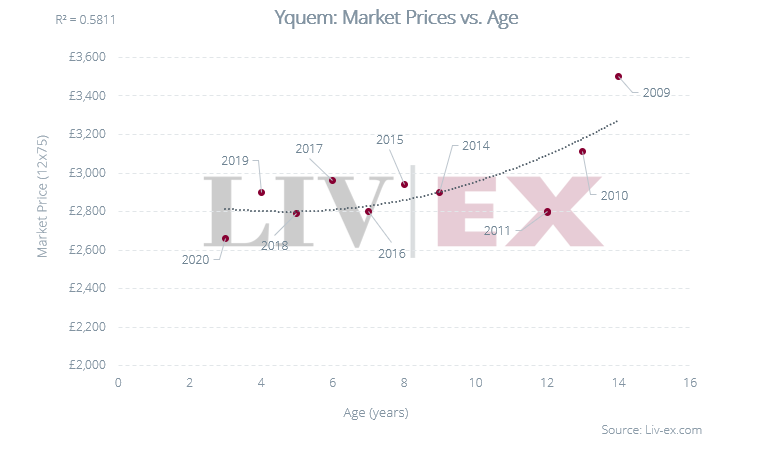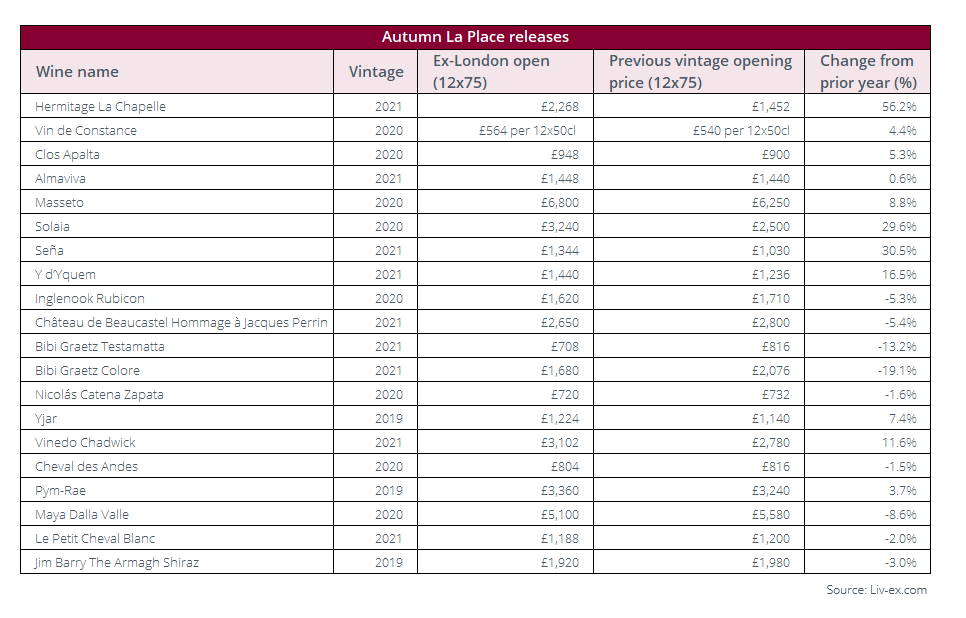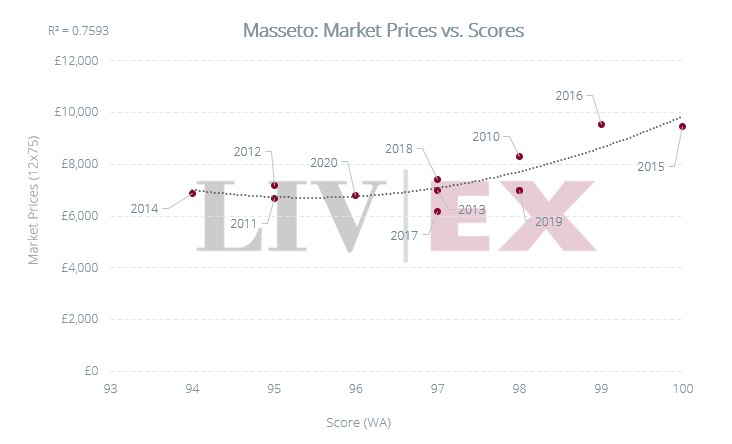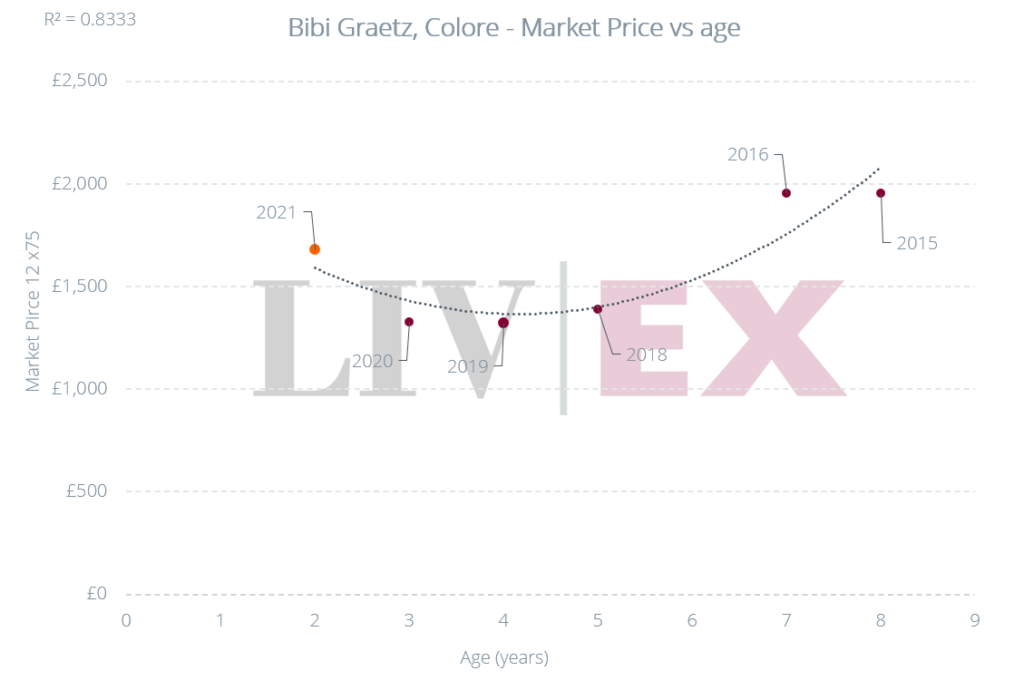October Market Report
- The Liv-ex Fine Wine 100 and Fine Wine 50 saw their decline slow, while other indices rebounded.
- The Champagne 50 ran flat, buoyed by recent releases.
- A look at the Fine Wine Investables highlights a turning point in its price direction.
- Château d’Yquem featured at The Wine Independent’s Summit Dinner; some of the wine’s 100-point vintages are available on Liv-ex.
- Last month was dominated by La Place Autumn releases; high prices and the rate of releases led to mixed reviews from the trade.
Introduction
Which way are the trading winds blowing?
*data taken on the 4th of October 2023. The FTSE 100 was last updated on the 29th of September. The Liv-ex Fine Wine 50 is updated daily.
In September, the Liv-ex Fine Wine 100, the industry benchmark, showed relative stability despite continued selling pressure in the broader market. The index declined by 0.1% month-on-month to close at 376.34. The Liv-ex Fine Wine 50 (which tracks the movement of First Growths) also fell by 0.1% (NB: this index is updated daily). The last two monthly declines have been notably milder than previous months.
However, looking at the broader fine wine market, the Liv-ex Fine Wine 1000 fell by 1.0%, slightly more than the 0.8% fall recorded last month. Year-to-date, the index has fallen by 10.4%.
Last month, we wrote that August’s figures pointed towards a buyers’ market. It appears buyers have indeed stepped up to the mark, witnessed by increased trading activity by both value and volume in September. Market breadth continued to expand steadily, with 2,202 individual labels (LWIN 11s) trading over the month, an 8.2% increase on August.
Whether the milder declines in the Liv-ex Fine Wine 100 and Liv-ex Fine Wine 50 are a sign of cautious optimism returning to the market or simply a ‘back to school’ moment, it is difficult to say, but the Liv-ex Fine Wine 1000’s decline suggests we’re not out of the woods yet.
* Liv-ex members can see price movements of individual wines in all the Liv-ex indices in-app using the Indices Explorer.
Major Market Movers
The Champagne (50) is flat
In August, only one sub-index of the Liv-ex 1000 recorded an increase, the Bordeaux Legends 40. The September figures are a tad rosier: the Italy 100 rose by 0.6%, the Rest of the World 60 index by 0.2% and the Champagne 50 flatlined (0.0%) to end at 619.72.
The recent release of some Champagne from the lauded 2013 vintage, such as Salon Le Mesnil Blanc de Blancs 2013 and Taittinger Comtes de Champagne 2013, gave the region renewed focus. September saw the highest number of individual wines (LWIN11s) in the Champagne 50 traded in 2023 year to date. The third quarter was also notably more active in terms of trade than the previous one.
As shown in the chart above, the Champagne 50 has significantly outperformed the Liv-ex 100, the Liv-ex 1000 and the Bordeaux 500 over two and five years. Within the Champagne 50, 30 wines experienced a month-on-month increase, Dom Pérignon 2005 was flat on the previous month and 19 wines experienced a decrease in their index value.
The highest riser was Cristal Rosé 2008, which saw a 10.9% month on month increase, but remains 6.4% down year-to-date. In terms of poorest performers in the index, Cristal 2013 declined by 7.7%, trailing behind Krug 2003, the weakest performer in the index, with a 10.3% drop.
Pol Roger’s Sir Winston Churchill is on the rise; all four of the wine’s vintages within the Champagne 50 (2008, 2009, 2012, 2013) have recorded an increase on the previous month. The brand has also observed a significant rise in trade by value and in the number of individual wines (LWIN11s) traded in September.
Year-to-date, trades of Champagne have been on average 5.3% below Market Price. 28.4% of Champagne trades have occurred 10% below Market Price, an interesting opportunity for buyers looking to stock up for Christmas.
Chart of the Month
It’s ‘decision time’ for the Fine Wine Investables
The price of the Liv-ex Fine Wine Investables has followed a rising trend since its inception. It is supported by an ascending long-term primary trendline (in red on the chart below) that remains intact at the end of September 2023.
The price action of the Investables has been relatively choppy compared to other Liv-ex Indices; for example, the price dropped 40% between 2011 and 2014. The index’s volatility is even more pronounced in the Relative Strength Index (RSI), an indicator used to measure the speed and depth of an index’s price movement, charted in black below.
The Fine Wine Investables’ Relative Strengh Index
The RSI has fluctuated from extreme overbought territory (over the ‘70 line’) to extreme oversold (below the ‘30 line’) territory numerous times. While the RSI is now in oversold territory, which can be interpreted as a buy signal, it has not yet broken the lows it previously achieved.
Since its all-time high at 415, the index price has been steadily falling and now finds itself in a significant convergence zone, which could offer support or see the price drop lower. Not only is the price re-testing its primary trendline at a level close to the 2011 highs, but it is also supported by the Simple Moving Average 50-months (SMA50), a long-term moving average which can be used to assess whether an index will continue on its current trend or reverse it.
Now is a critical time in the index’s evolution. If the price bounces off this major convergence zone, the reaction against the 7-month SMA will need to be monitored; this short-term moving average might indicate whether the rebound will last in the long-term. The next potential support for the index would be at 349 (its 2018 high point), just below the 38.2% Fibonacci retracement, the dotted green line on Chart 1 indicating support or resistance levels.
What is technical analysis?
Technical analysis is a method of forecasting future market movements by studying previous movements, on the basis that historical trading activity can be a valuable indicator of the future This tool is common in financial markets and is applied here to Liv-ex indices in order to evaluate investments and identify trading opportunities.
Critical Corner
The Wine Independent on the golden boy of Bordeaux
Attendees of The Wine Independent Summit Dinner were served 15 vintages of Château d’Yquem, going back as far as 1876. Lisa Perrotti-Brown MW commended the sweet wine’s incredible longevity, going as far as calling it ‘elixir immortal’.
The estate, which dates back to the 1300s and is currently owned by LVMH, was classed as a ‘Superior First Growth’ (Premier Cru Supérieur) in the 1855 Classification – the only white wine to achieve that status. Today, Yquem continues to live up to its reputation, despite some challenging recent vintages weather-wise.
The chart below shows The Wine Independent scores for Château d’Yquem spanning back to 1996. The Market Prices are fairly consistent over the years, aside from the 2001 vintage which is currently available for £5,200 per case. It was scored 100 points by Lisa Perrotti-Brown, who called it ‘the epitome of a Sauternes experience that is as cerebral as it is hedonic’. It was also scored 100 points by Neal Martin and Robert Parker.
Interestingly, two other more recent vintages have also received full marks from The Wine Independent but are available for a much lower Market Price than the 2001. The 2009, for example, is available at a Market Price of £3,500 per case. The wine last changed hands at a price of £1,900 per 12×37.5.
Five vintages of Yquem received 100-point scores from The Wine Independent since 1945. The 2001, 2009 and 2015 are listed live on Liv-ex at the prices below for anyone wishing to deck their Christmas tables with this liquid gold.
It’s also worth noting that Yquem Market Prices are 58.1% correlated with age, meaning vintages tend to appreciate in value with the passing of time. The 2011 vintage stands out as falling below the fair value line, meaning it offers relative value compared to other vintages. It was scored 95 points by Lisa Perrotti-Brown, Jane Anson and Neal Martin and is available at a Market Price of £2,800 per case.
There are 125 LIVE bids and offers on Château d’Yquem on Liv-ex. Log in to the exchange to view them and trade.
Final Thought
La Place releases: Too much, too late?
Reinvigorating the fine wine market and restoring faith in the La Place distribution system. If that sounds like a tall order, that’s because it is – yet that was the challenge that was resting on the 2023 Autumn Releases. The results were decidedly mixed, with many merchants deploring the high volume of releases of relatively unknown wines at unrealistic prices.
The releases began as the market recorded its eleventh month of consecutive declines; all major Liv-ex indices fell in August, albeit at a slower rate than previous months. Buyer sentiment was decidedly cautious, undermined by ongoing interest rate hikes and global economic uncertainty.
The mixed reception given to En Primeur 2022 releases should’ve been a good indicator of the challenging market conditions: in many cases, the promise of an exceptional vintage was not enough to withstand the hefty price increases implemented by many estates. There was hope then that Beyond Bordeaux, the story would be different.
Hermitage La Chapelle 2021 kicked off the show, making its début on La Place at £2,268 per 12×75, up 56.2% on the previous vintage’s opening price. The following week saw release price increases across the board, from a modest 0.6% year-on-year rise for Almaviva 2021 to 29.6% and 30.5% rises for Solaia 2020 and Seña 2021 respectively, as shown in the table below summarising 20 major La Place releases covered by Liv-ex.
Those bold price hikes were not there to stay, however. Interestingly, close to halfway through the campaign, pricing started trending downwards. Bibi Graetz’s Testamatta and Colore 2021 were released 13.2% and 19.1% below their previous vintages’ opening prices respectively. Argentine wines Nicolás Catena Zapata 2020 and Cheval des Andes 2020 were also released at marginal discounts to their 2019 vintages.
Can this change of direction be explained by producers looking to their neighbours and reading the market’s mood? Maybe. However, it’s worth noting that year-on-year price changes aren’t the only factor at play when it comes to these wines’ reception.
Despite opening at an 8.8% premium to the 2019 vintage, Masseto 2020 is offered at fair value, as shown in the chart below. The wine has enjoyed relative success so far according to members of the trade.
On the other hand, a lower release price does not necessarily lead to a successful release. As mentioned above, Bibi Graetz Colore 2021 was released below the 2020 vintage’s opening price, but according to Liv-ex’s Fair Value methodology, it came in above the fair value line, meaning other vintages might offer better opportunities for buyers.
Since its release, Colore 2021 has traded multiple times on Liv-ex, all below its release price of £1,680 per case.
This campaign also saw estates who took stock of the market and decided not to release at all, choosing to wait for better conditions to return – a luxury not available to all. Two Bordeaux estates thus opted out of this year’s campaign: Château Palmer did not go ahead with its N-10 ex-cellar release, and Château Haut-Batailley held on to its 2021 Verso.
While these absences were felt, they did not make a dent in the crowded release calendar. Some days saw upwards of five releases from different parts of the world, with varied price points and quality levels.
Overall, the feedback from the trade is one of disillusionment – the returns made did not justify the time and effort (and for some, the reputational damage) required by the intensity of the campaign’s pace and the prices demanded. Private collectors were not only mostly uninterested, but many also simply unsubscribed from the stream of email offers.
As with the spring campaign, few doubted the quality of the wines on offer (for some, the best ever made), but the release prices simply ignored the reality of today’s market. In the words of one négociant: ‘It felt like Bordeaux 2022 all over again – wrong prices, in the wrong order, into the wrong market’.

